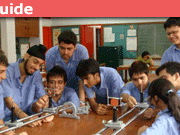How to Publish in a Physics Journal As a Physics Major
Full Chapter List - So You Want To Be A Physicist... Series
Part I: Early Physics Education in High schools
Part II: Surviving the First Year of College
Part III: Mathematical Preparations
Part IV: The Life of a Physics Major
Part V: Applying for Graduate School
Part VI: What to Expect from Graduate School Before You Get There
Part VII: The US Graduate School System
Part VIII: Alternative Careers for a Physics Grad
Part VIIIa: Entering Physics Graduate School From Another Major
Part IX: First years of Graduate School from Being a TA to the Graduate Exams
Part X: Choosing a Research area and an advisor
Part XI: Initiating Research Work
Part XII: Research work and The Lab Book
Part XIII: Publishing in a Physics Journal
Part XIV: Oral Presentations
Part XIII: Publishing in a Physics Journal (Addendum)
Part XIV: Oral Presentations – Addendum
Part XV – Writing Your Doctoral Thesis/Desertation
Part XVI – Your Thesis Defense
Part XVII – Getting a Job!
Part XVIII – Postdoctoral Position
Part XIX – Your Curriculum Vitae
At this stage, you are well into your Ph.D. research work, and depending on what area of physics you are in, you may already start producing new results. This next part of the series will cover an extremely important aspect of your graduate work that is typically not covered (sometimes not even required) in your graduate school requirement. It is the aspect of publicizing your work. Your graduate school curriculum will not have much, if any, on this. Yet, as a physicist, this is one of the most important aspects of your profession.
There are two major means by which physicists publicize and report their work – via physics journals, and via presentation at physics conferences. In this chapter, I will first cover journal publications and will reserve a conference presentation for the next chapter.
If you have ventured into your library, you will notice that there are hundreds of physics-related journals or journals that accept physics papers. While a lot of these journals tend to specialize in a particular area of physics, there are three journals that are considered to be very prestigious for physics publications: Nature, Science, and the Physical Review Letters.
Nature and Science publishes scientific papers in general, not just physics. They also tend to be extremely selective on what appears on their pages. One criterion is that the work being reported must have widespread appeal or importance, not just within the confines of that particular area of study. So things that claim a discovery of never- observed phenomenon, such as fermionic condensates, or apparent superluminal group velocity propagation, are the types that the editors of these journals look for. This criterion adds to the difficulty in getting published in these journals. In many cases, manuscripts submitted to these journals do not even get past the editors. They are often rejected before the manuscripts reach the referees. Phys. Rev. Lett. publish exclusively physics and physics-related papers. Because of this, they tend to publish more physics papers per week than Science and Nature combine. But they are no less difficult to get through. The editors, while still more forgiving than the editors of Science and Nature, will ramp up their review of the submitted manuscripts and will be more discriminating of what they sent to their reviewers. Now unlike Science and Nature, Phys. Rev. Lett. has a page limit to 4 typeset pages. So articles submitted to be published in this journal will have to be able to convey their messages within that limit.
I will now describe the typical process that one goes through in trying to get one’s work published in a physics journal. Since the largest ”family” of physics journals is the Physical Review series, I will use the process of getting published in one of these journals as a concrete example. However, the method is quite generic and can be adapted to any reputable physics journal.
To publish a work, you need to be very clear what is the single, most important message you are trying to get across. Once you, your adviser, and your collaborators agree on that message, it is time to figure out how to convey that in the most effective and CONVINCING manner. Figure out what results must be included, what data must be presented, what figures are needed, and how to show all of these in the clearest possible manner. There is no point in having an important thing to say, but saying it in a confusing, obtuse manner that makes it difficult to understand. Your message will tend to be lost, not only to the reader but more importantly, to the people who will review your work. This is a formula for rejection.
Once you have decided what to present, you will have to decide where you might submit such a work. Note that in many instances, this is often decided later, after the manuscript is written. However, more often than not, your adviser and collaborators will know how significant the work is, and will already have some idea in mind on which journal to aim for. If this is the case, go to the journal website, and look for instructions from the authors. The journal will have a clear set of guidelines on the format that it will accept for submission. Often, they also will have a template that one can use as a guide. This is especially helpful because it can allow you to typeset your manuscript to look like what it would appear in the final print. It allows you to judge the length of your paper, which is important for journals like Phys. Rev. Lett. which has a page limit.
It goes without saying that you should already be familiar with the journal you want to submit to. All that literature search that you did while trying to familiarize yourself with the field of study that you went into (see an earlier So You Want To Be A Physicist chapter) should make you comfortable with many physics journals. So look at a paper from that journal and pay attention to how the authors present their work. This will be a very good illustration of what works.
Now that you know what to write, where to send it to, and how to present it, it is time to write. This is where you will regret all those complaints you had in your writing classes. It is most likely that if you were the one who did the significant portion of the work that you will be the one to write it. All journals require that the manuscript requires an abstract, an introduction, the body of the work, and possibly a conclusion or summary at the end. This is true even if there are no structured sections that are part of the style given by the journal. Such things are helpful for people who want to do a quick browse of a paper. When you have understood this, then write! Keep in mind one unavoidable fact: your manuscript WILL go through several iterations before everyone involves will agree to it. This happens to everyone, no matter how many times we write and publish our papers. You will learn that different people prefer certain phrases, emphasis, style, etc. Do not be discouraged by this. Discuss why you think certain things should be said in certain ways (example: Why should you not say ”this result proves that…” rather than ”.. this result is consistent with…”). You will learn how certain words and phrases can cause problems during the review process that you may not anticipate. These are all things that you will pick up along the way as you write your first, and subsequent papers. There’s no way to learn other than by doing it yourself.
Note that it is not unusual for a number of people to share writing the manuscript. Maybe someone will write one part of it, and you write another part, while your adviser writes the rest. However, what is more, common is to have just one person starting out by writing the first version, and then it gets passed around to a number of people for corrections, additions, modifications, etc. I find this to be more efficient than the first, and the paper tends to at least be more coherent as a whole rather than a mishmash of different styles.
Physics papers tend to have figures, especially graphs. You need to have good graphing software. This goes without saying. You will also need to be aware that the figures tend to be rather small when it appears in print. So make sure your letters and numbers will be legible when they are compressed to the typical size of that journal. This is where having a template from the journal and inserting the figures yourself can be useful. You can see how it may appear in the end and see for yourself if you need to make certain things bigger/clearer. See if your figures have too much clutter that someone who is not familiar with your work will find it difficult to decipher what you are trying to convey. Always keep in mind that you are trying to convey some information to someone who is not familiar with what you are doing. Being brief and right to the point is always important.
Unless you are Albert Einstein, your paper will have references. Again, look at a paper from that journal to see the format on how references are cited. However, more importantly, you need to make sure you did not miss an important work that needs to be cited. This is where your adviser will be useful. He/she will probably know what you should include in your citations. If you don’t, don’t be surprised if the referee will come back and ask you why you missed so-and-so. This is where, if you have followed the earlier advice on doing an extensive literature search, you would have known who did what when, and why such a thing needs to be included. Be aware that you can ruffle a few feathers if you left out something you should have cited. The people who are also in your field will tend to remember that you neglected to cite their work when it was appropriate to do so. They might just do the same when it is their turn. You do not want to put the wrong foot out especially when you’re just starting out. So do your homework.
Who to list as the authors on your manuscript is initially the decision of your supervisor/adviser. If you did the work, and are the primary writer, you should be listed as the first author. However, this rule is not followed all the time. Sometimes, unfortunately, it is a matter of politics on who gets listed, and where. Typically, those who did the most work get listed first, and the list follows the degree of contribution to that work.
[Addendum to the original article – In experimental high-energy physics papers, the number of people participating in the work can be HUGE, often more than a hundred. It is usually difficult to pick a single person who did more work than others in such a collaboration. So for such papers, the authors are listed alphabetically using their last names.]
I suppose this is also the place to tell you that if you do not know how to write LaTex codes, this is the time to learn. The Physical Review journals, especially, prefer LaTex format as the submission document, while the figures have to be in postscript (PS) or encapsulated postscript (EPS) files. There are several graphical Tex editors that allow you to type your document and mathematical equations very easily (the FULL version of MathType Equation Editor that comes with Word can convert equations into LaTex codes). So you don’t really have to learn that much. Note that if you submit your documents in the format that they prefer, you get a discounted publication fees for Physical Review journals (more on this later).
When you are ready with a final manuscript, it’s time to submit it. All of the major journals now prefer electronic submission. Go to the journal’s website for explicit instructions. Once you have submitted your manuscript, you will be given a manuscript or submission code. This is the reference number you and the editors refer to whenever there are communications between the two parties. It is also the code that the referees are given if and when your manuscript is evaluated. The editors will determine if your manuscript satisfies the standard requirement for the journal. If it does, it will be submitted to either one or more than one referees. For journals such as Science, Nature, and Phys. Rev. Lett., 2 referees are normal, 3 is not unusual, and 4 or 5 is not unheard of. These referees are anonymous to you, the author. On the Physical Review author’s webpage, you can actually track the progress of your manuscript and at what stage it is in. So you can tell if it has been sent to the referees, and when the referees have responded back to the editors.
The responses from the referees determine the next step that you have to make. There are several possible outcomes:
(i) ALL the referees give a positive review and agree that your manuscript deserves to be published. You may need to make minor changes, but overall, it is accepted. Then congratulations! The editors will give you instructions on what you need to do if you have to make minor modifications, etc. But don’t get used to this. This doesn’t occur often. More likely on what would happen is an option (ii)
(ii) which is one referee has a set of comments/questions, but gives a positive review, while the other referee doesn’t give a positive review and also has comments/questions. When this occurs, you will have a chance to submit a rebuttal and make changes to your manuscript to take into account the referees’ comments, suggestions, etc. I strongly suggest you make a much of an attempt to accommodate the referees’ suggestions. It will show that you respect their opinions and may make the 2nd round of review smoother. You then resubmit your manuscript and usually, the same referees will get to review it again unless one or more of the referees refuse to review it again for some reason (this has happened before to yours truly). If all goes well, you’ll get all positive reviews and your paper is accepted. But it can happen that even after the 2nd round, you still do not get unanimous approval. When this occurs, you need to pay close attention to the journal’s policy. Most journals would view this as an automatic rejection. You might as well try to submit your manuscript to another journal. Some journals, such as the Physical Review journals, will give you the final option of appealing to the associate editor. You’d better have an extremely good reason to do this because it will again take some time for the process to occur and you really, really want to get your work published in that particular journal.
(iii) you get all negative reviews on the first round. This again will usually result in an automatic rejection. You can appeal or send in a rebuttal, but there’s a good chance you won’t get through if the editors see that all the referees agree that it shouldn’t be published. If this occurs, my advice is to go to a different journal.
Writing papers is a necessary part of your career as a physicist. Many started out with a series of publications by the time they completed their Ph.D. work. You need to establish your reputation by the time you graduate, to make your credentials stronger in your search for a post-doctoral position or employment. Your adviser should help you in making sure you have a few publications under your belt by the time you are done. So such an exercise is a necessary practice in becoming a physicist. You should not be satisfied with your graduate work until you have at least a publication to your name.
PhD Physics
Accelerator physics, photocathodes, field-enhancement. tunneling spectroscopy, superconductivity








Sometimes I found papers accompanied by a supplementary material, in whcih usually the author elaborates his method and/or derivations to the formulae appearing in the main paper. Is there also limitation on the number of page of the supplementary material?As mfb said, it depends on the journal. Often the supplementary part is available only online, it isn't refereed, and it is usually minimally formatted and typeset. This means that the cost, if any, to the journal is minimal. So I doubt that it counts as part of the publication fee. How that is handled in journals such as PRL that has a strict page limit, I'm not sure.
Zz.
If the supplementary material is managed by the journal, it might depend on the journal.
In high-energy physics (probably elsewhere as well but I don't know) this material is available independently of the journal, so there is no page limit. Sometimes you even get an internal support note for a public support note, which can have 200+ pages.
Sometimes I found papers accompanied by a supplementary material, in whcih usually the author elaborates his method and/or derivations to the formulae appearing in the main paper. Is there also limitation on the number of page of the supplementary material?
These are all things that you will pick up along the way as you write your first, and subsequent papers. There’s no way to learn other than by doing it yourself.Get paper drafts from others and review them, then discuss your comments with others.
This is always done in experimental particle physics within the collaborations, but it is possible elsewhere too.
Physics papers tend to have figures, especially graphs…. and you should be able to change elements in the graph easily (i. e. not with photoshop) because you probably have to do so between the first draft and the final paper.
[Addendum to the original article – In experimental high energy physics papers, the number of people participating in the work can be HUGE, often more than a hundred. It is usually difficult to pick a single person who did more work than others in such a collaboration. So for such papers, the authors are listed alphabatically using their last names.]For the same reason, it is also typical that the collaborations maintain a single author list. Everyone on that list gets listed as author for every paper, regardless of the contribution to this specific paper.
Preprint servers could be worth a note, given their importance in some fields.